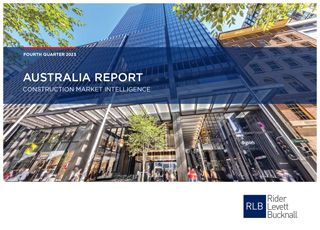According to the Rider Levett Bucknall (RLB) 4th Quarter 2023 Australia Report, construction cost escalation has stabilised from the peak levels of 2022 but remains a significant concern for the sector.
Director Domenic Schiafone commented, “It’s a complex issue with many factors at play. Escalation increases seen across all Australian cities are being driven by a combination of skilled labour shortages, supply chain issues, global surge in energy prices, domestic issues such as contractor solvency, regulatory impacts and rising interest rates.”
Cost escalation leading to delays and cancellations
He noted, “Project delays and cancellations are a specific impact of current cost escalation. Increased construction costs, holding costs and general project feasibility have made it difficult for some projects to proceed as planned, leading to delays and even cancellations.”
“Another impact is the financial strain on contractors (fixed-price contracts exposed contractors, sub-contractors and material suppliers to significant financial risk due to unforeseen cost increases) and impact on affordability,” he added.
Rate of cost escalation slowing down since 2022
While cost escalation remains a concern, the rate of increase has slowed down in 2023 compared to 2022. This suggests some stabilisation in the market, which is reflected in the levels of escalation forecast for 2024 in the table below.
Brisbane and Townsville are the Australian cities forecast to experience the highest increase in tender prices across 2024 (both with an estimated 6% increase) and 2025.
According to RLB’s Australia Report, the Queensland State Government is in the process of awarding up to 15 major hospital projects ($10bn), which are likely to put pressure on an already stretched pool of resources. This is likely to result in further construction cost increases in 2024 commencing with structural trades and progressing through the balance of the trades in 2025.
High demand and lack of supply causes fall in productivity
Domenic continued, “In addition to the health program, there is also a $5bn corrections program and an $3bn education program, followed by the Brisbane Olympic Games venues and infrastructure. As a result of high demand and lack of supply for resources, productivity levels have fallen significantly, and contractors are increasing project durations due to lower productivity. As a result, there have been increases in time-related preliminaries and the pricing of risk through contingencies and margin.”
In Brisbane, residential construction, both house and land, and apartment developments have slowed considerably across as increased construction costs negatively impact the feasibility of projects and rising interest rates have reduced demand and compressed sale prices.
Government-led spending in Melbourne continues
RLB found that the Melbourne construction market continues to be driven by government led spending on infrastructure, health and housing and the continued influx of build to rent developments. Elsewhere, activity is also strong in the logistics and industrial sectors. While the low to mid rise build to sell apartment sector remains positive, there is caution as construction costs, land prices and other financial inputs suffering from high inflation are impacting the feasibility of new projects. The availability of labour, a problem for some time, continues to contribute to high escalation across the industry and low productivity.
Residential and commercial sectors subdued in Sydney
In Sydney, the construction market continues to be centredlargely around continued government led hospital, school and infrastructure projects, with residential and commercial sectors subdued due to interest rates and inflation, and oversupply issues.
As expected, the rejuvenation of existing and ageing B & C grade assets has commenced following the influx in premium-grade offerings within the CBD and its surrounds. Owners are considering adaptive reuse of these assets to maintain relevance within the current market. Build to rent has cemented a foothold in the Sydney market, with the first tranche of projects commencing and future projects being considered.
Major projects in the long-term pipeline include Castle Towers, Ryde and Cumberland Hospitals, Powerhouse Museum, and the Metro West Stations including the over station developments located at Hunter Street in the Sydney CBD, Pyrmont, Parramatta and Sydney Olympic Park.
Supply chain issues still causing widespread disruptions
According to RLB, supply chain issues are still causing widespread disruptions in the supply of essential construction materials like timber, steel, quarry products and concrete. This is being caused by an ever-increasing lack of domestic supply and logistical issues in sourcing product from overseas and has led to shortages and significant price increases.
The global surge in energy prices has impacted the manufacturing and transportation of construction materials, further adding to cost pressures.
Domestic factors include the strong domestic demand for construction services, contractor solvency, regulatory impacts and rising domestic interest rates.
Government implementing measures to support construction industry
Moving forward, RLB forecasts there will be focus on risk mitigation. Construction companies are increasingly adopting strategies to mitigate risks associated with cost escalation, such as being more flexible in risk allocation in contracts, early contractor involvement in the design development phase of project planning to mitigate design and construction risks, and the use and supply of alternative materials.
Domenic concluded, “The Australian Government has implemented some measures to support the construction industry, such as infrastructure investment programs and skills development initiatives but the results of these endeavours will not be seen for a number of years.”
FURTHER INFORMATION:



